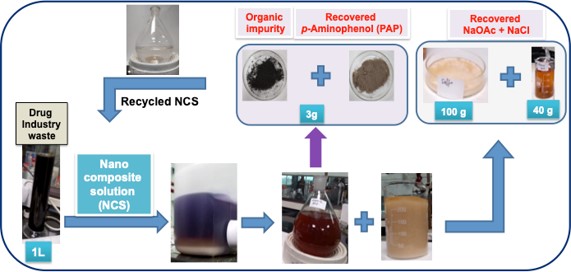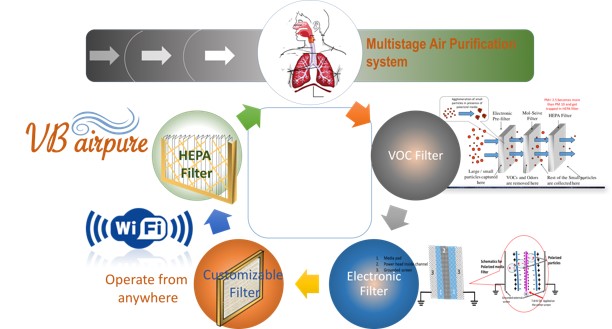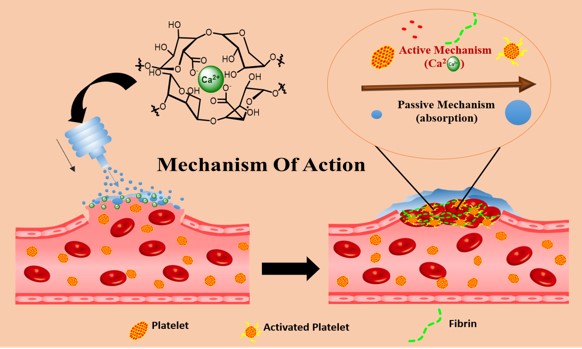IPR / Technology
We have developed a technology/process for industrial effluents waste water treatment which is self-sustainable and zero waste so as to safeguard aquatic systems present in the environment. Although we have optimized this process for paracetamol industrial effluents, the similar procedure could be extended for other pharmaceutical or dye industries after optimization study.
This study involves the formulation of a simple, efficient and economical method for the recovery of para amino phenol (PAP) and sodium acetate/chloride salt from the industrial effluent obtained for the preparation of paracetamol/acetaminophen drug. While PAP is the precursor for the synthesis of paracetamol, sodium acetate salt comes as a side product. This is because the acetylation of PAP using acetic anhydride involves the crude PAP along with sodium chloride. As a result, a huge amount of ~8-10 tons per day per industry of the PAP precursor and the ~60-70 tons of salts per day per industry get released in to the water bodies as industrial effluents for a company producing 138 tons of waste effluent a day, which eventually cause harm to the biota. Here, we have formulated an efficient method which could separate and rejuvenate these products from the waste. Our technology delivers the following salient points. i) A process development that can achieve complete recovery of soluble para amino phenol from the mother liquor; ii) The process leads to the separation of valuable components which has significant economical values; and iii) The affordable process leads to self-sustainable, environmental friendly waste management system.
An alternative solution for the above problem is to degrade organic pollutant using recoverable catalyst which is active even at simple conditions like in aqueous system, without heating and light requirements.
Up to 5L scale have been tested
Currently, in discussion with companies in order to test and implement industrial application.


Globally 40–50% of the fruits and vegetables produced in the field are lost before consumption. Consumption of preservatives like benzoic acid cause acidosis, convulsions hyperpnoea and idiosyncratic. Preservatives like sorbic acid are potential mutagens. GO platform was loaded with model preservative and the composite was used to prepare carbon wrapper.
Unlike cellulose these wrappers are more robust and withstand multiple cycles with the preservative.
(1) Patented process for synthesis of an efficient adsorbent.
(2) Tested for rare earth metal, transition metal ions, organic pollutants and ground water treatment. Removes metal ions, organic impurity along with biological impurities. Flow rate 2 L/min. Capacity = 7000 L.
Product Technology Transfer under discussion with Bio-Age for making low cost water purification system


1) Electronic pre-filter uses electric field to agglomerate the sub-micron size particles and can be trapped in the filter.
2) Customizable filter which will not only absorb the volatile organic compounds (VOC) but also are capable of removing ammonia or any other major pollutant from the air. This filter is based on nano-porous material which have very high surface area and can adsorb high concentration of pollutant.
3) HEPA filter which can trap particulate matter above 2.5 micron. It uses electric field to agglomerate the sub-micron size particles that can be trapped in the filter.
Reusable Nano-hybrid filter: Gas specific adsorbent based on mesoporous carbonaceous materials, with high affinity for VOC, ammonia, NOx and SOx which makes it a unique filter.
After a serious injury, few challenges are more urgent than stopping life-threatening bleeding. Biodegradable microparticles that combine to form a gel on a wound offer significant improvements over existing alternatives.
Topical hemostatic agents are an important means of controlling bleeding where conventional methods are inefficient or impractical. A topical hemostat with potential for use in hospitals and health care centres has been developed. In addition, due to its simplicity in application, it can be used by untrained personnel at homes, in trauma cases and by the armed force personnel. The hemostat has the following properties
Haemostasis observed following application of the topical haemostat.
